The sauna in the apartment: assembling ready-made sauna or build "from scratch" by yourself
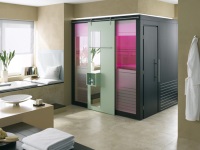
Visiting the sauna is considered a useful procedure, but city dwellers often do not have time to regularly visit the steam room. However, sauna lovers have the option of installing a sauna directly in their apartment. Such a sauna can appear in urban housing in the form of a factory cabin or be created by your own hands.
By installing a sauna in your home, you will be able to relax in the comfort of your own apartment. Moreover, for this additional plumbing and pipes are not required, because the cabin is connected to the existing mains.

Using home sauna has a positive effect on respiratory health and cardiovascular system. Also these procedures help detoxify and rejuvenate your skin. Visiting the sauna at home after a physical exertion, you will recover your strength. In addition, relaxation in the sauna will help in overcoming stress.
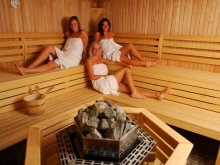


Recommendations and legal subtleties
Not so long ago, it was impossible to install a sauna in an apartment, but now, despite the need to obtain permission, the idea of installing a sauna at home is not unrealistic.
To design a sauna in a city apartment, you will have to adhere to the following conditions:
- heating in a home sauna is allowed only from a special factory-made furnace. In such a furnace there is a shutdown for continuous 8-hour operation and a temperature above +130 degrees;
- In order to spray water, a drier or a perforated pipe is installed in the sauna. The connection is made to the water supply system inside the apartment outside the sauna;
- the area of the home steam room must be up to 24 m2;
- The wood must be treated with a special impregnation against fire and rotting;
- The sauna must not be located in a residential area.
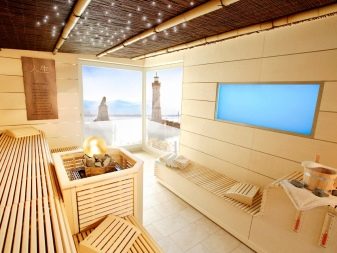
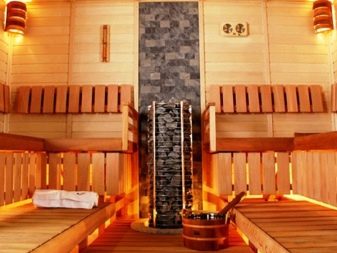
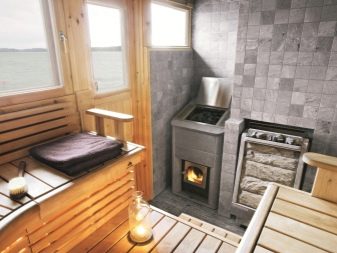
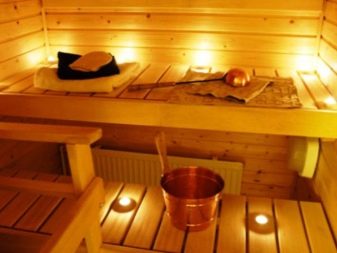
To approve the draft of the sauna in the apartment you need to visit several authorities - Sanitary and Epidemiological Station, HOA, Housing Inspection, Fire Safety Authority and others. The list of services and institutions that need to obtain permission for the installation of the sauna may vary in different regions, so it is better to specify in your area of residence.
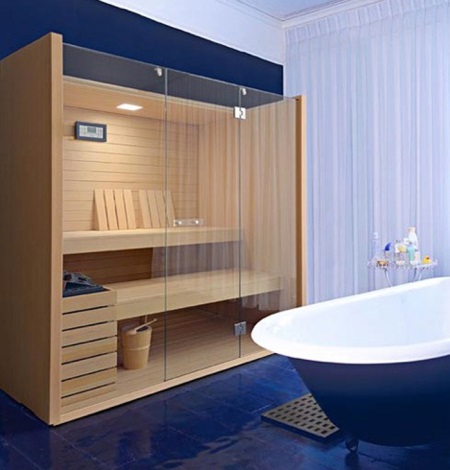
Requirements
Since the sauna is considered a fire hazard, there are certain requirements for its installation. The main requirement relates to the choice of the heater. In the home, only infrared or electric heater can be used, and gas and solid fuel appliances are prohibited. Keep in mind that the electrical wiring in the house must be sufficiently powerful, so its condition should be known in advance.
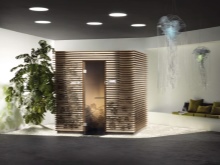
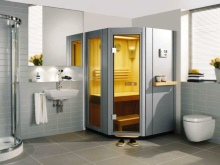
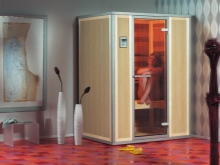
When installing the sauna itself in the steam room requires the installation of a sensor that automatically turns off the heating element when a certain temperature is reached. You also need another sensor designed to give a signal to the Ministry of Emergency Situations in case of fire in the sauna.
The second requirement for a home sauna is to ensure the removal of moisture from the room by means of a corrugated pipe. Quality ventilation will prevent the formation of condensation on the walls of the sauna and the development of mold. The room must also have good vapor and water insulation.
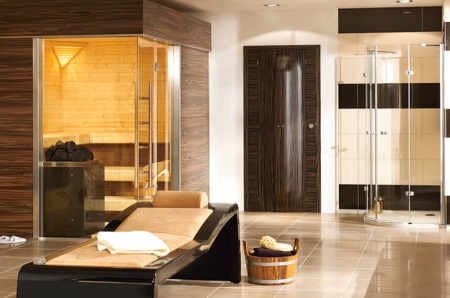
Choice of equipment
Sauna for installation in the apartment consists of such parts as a special furnace and cabin. The choice of stove power will be influenced by the area of the future steam room. For each 1 m3 of space, calculate 0.6 kW of power. Buying a more powerful device, you will spend more electricity (and this is an unnecessary expense), and if the furnace is underpowered, you will have to wait too long for the sauna to heat up
The cabin can be collapsible (factory design) or made by your own hands. The wood for such a cabin is spruce, alder and other conifers, less often linden or aspen. To fix the cabin used ceiling and corner strips of metal. To humid air out of the sauna, provide ventilation grates.
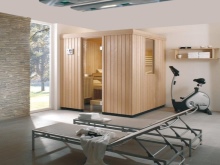
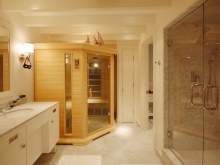
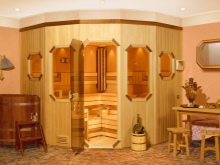
The floor in the home sauna must be able to withstand the conditions of high humidity, as well as temperature. Galvanized steel or aluminum is used for its frame, but those who like naturalness, often choose wooden planking (lattice).
To the equipment for the sauna at home also include beds, the number of which is chosen based on the future use of the room. Usually, beds are made of durable smooth wood and presented in U or L-shape.
Installation
Usually prefabricated sauna is placed next to the shower or bathtub. These saunas come complete with an oven, lattice furniture, wiring, lights, and sometimes a shower.
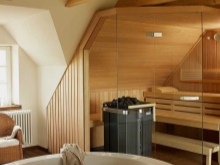
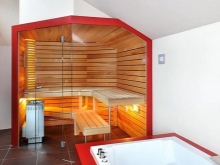
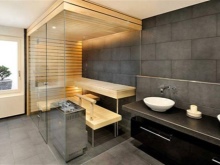
For the installation of the walls and roof use panels. Installing the shields, all the joints are tightened with foil for better sealing. It is important to ensure good waterproofing and to lay the cladding material before installing the sauna.
Prefabricated saunas can also be purchased to order with the dimensions, equipment, as well as accessories that the customer wants. Another plus is the possibility of finishing such a sauna with plasterboard on the outside, which makes it easier to decorate it to match the design of the room. One of the current trends is the production of prefabricated saunas with walls (1 or more) made of heat-resistant glass.
Sauna with your own hands
Making your own home sauna is a more complicated but economical option. For the frame, they usually use wood, creating a panel construction, represented by 2 layers of linings and a layer of vapor and thermal insulation between them.
The longest service life is characterized by sauna cabins made of coniferous wood. You will also need boards (to make the floor and beds), electric furnace, foil, heat-resistant cable, door, lights and other elements.
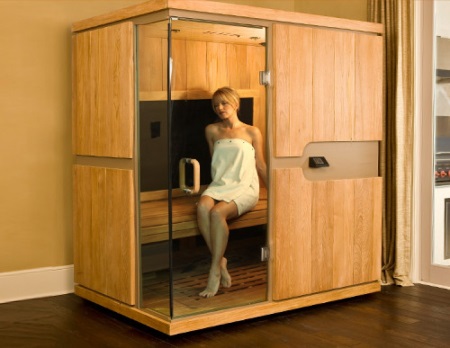
The work begins with the preparation of the bathroom walls, which must be cleaned to a concrete base. Next, tile or planks are laid on the floor, and cable is laid. After treating the walls with disinfectant, a framework is attached to them and the ceiling, which is made of wooden beams. In this frame is laid insulation, and the foil is laid on top.

The next task will be cladding the walls and ceiling with battens. Next perform the installation of benches and installation of the factory furnace. The final actions will be the installation of a door that opens outward (wooden or glass), the installation of the exhaust port in the far corner of the stove, as well as the installation of lighting fixtures.
It is worth noting that the sauna can be located not only in the bathroom, but also on the balcony or in the corridor. It is desirable that in this case the sauna was tied to 3 walls, but the extreme allowable variant is the use of one load-bearing wall. If such a wall borders on the street, it is worth leaving a space for ventilation between the sauna and the wall to prevent it from fogging up.
What to do if the wiring is not designed for the required load
Installation of a home sauna will be more difficult in apartments that use a gas stove, because the electrical wiring in such housing is not able to withstand the high loads. They require reconstruction of the electrical system, which must necessarily be coordinated.
The solution would be to buy a stove with low power. Since the load in these conditions should not exceed 3-4 kW, and you need to consider other electrical appliances, then pick up the stove power up to 2 kW. However, in such a sauna the temperature will rise for a very long time, so to speed up the process you need to take care of quality thermal insulation.
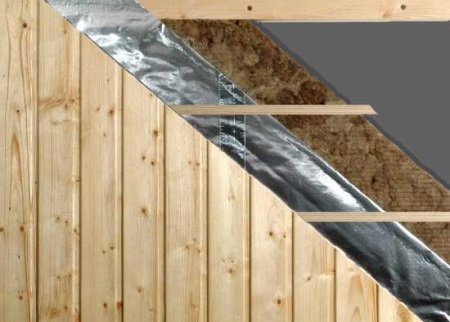
In order to use the sauna at home safely, it is important to install a separate power cable that connects the sauna heater to the switchboard.
Inside the sauna, the wiring must be installed only covertly - the cable must be heat-resistant and hidden under the cladding. The sauna must be earthed and protected by using a RCD. In a house with an electric stove, a 3-4 kW sauna heater will not place a large load on the mains, but the heater should be connected to the phase intended for the electric stove. It is not a good idea to turn on the stove while the sauna heater is in operation.
Types of saunas for city apartments
Nowadays, the options for apartment saunas are quite diverse, differing in their volume, design, heating method and additional functions. Here are the types of saunas you can install in an apartment:
Ready-made sauna with an electric heater.
Its area can be from 1.2 m2. This type of sauna is often chosen for a small family. Its advantage is its simplicity of installation since the prefabricated sauna is often made of wooden, easily assembled panels. It can be assembled by 2 people. Thermal insulation and vapor barrier is already present in the design, so you only need to bring the assembled booth to the communications.
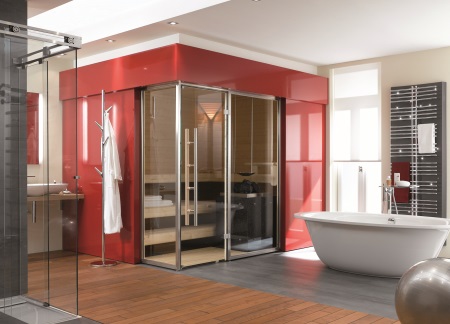
Heated tub
The advantages of this type of sauna for apartments - it requires a minimum of space and does not have to reinforce the electrical wiring. The model is represented by a wooden barrel of a special design. You can enter it from the side, and when a person sits down on the shelf, his body is inside the barrel and his head is outside. Such whirlpool is used for steaming the body with herbs that have healing properties and a very pleasant aroma.
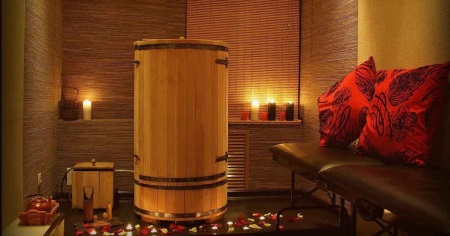
Portable Sauna
By design, it is a specially made frame, which is covered with a cloth. In terms of action, this type of home sauna is similar to a phyto-bath, as the head is not affected by the heat. The main advantage of the portable sauna is the ability to take the procedure anywhere there is an outlet. Also, this sauna is inexpensive, lightweight and compact.
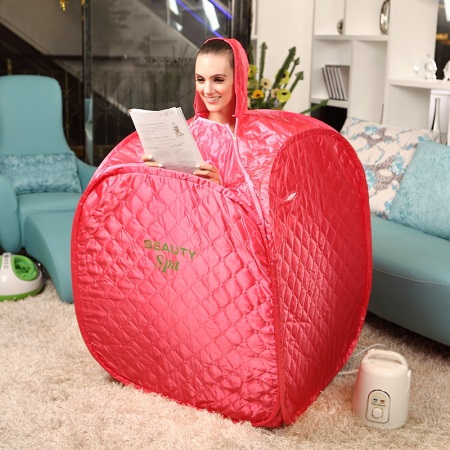
Infrared sauna
It is heated by an infrared radiator. It warms up the skin deeply, but the temperature inside the sauna is considered gentle (it is within 40-60 degrees), so children, the elderly, as well as people with vascular and heart disease can stay in this sauna. Such sauna consumes little energy.
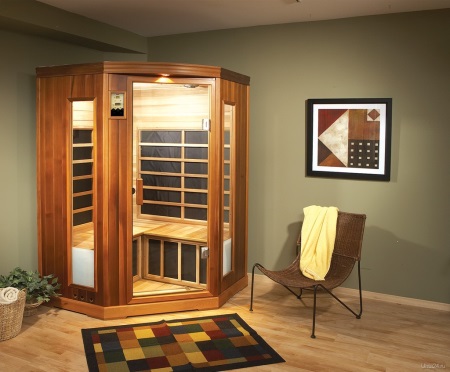
Finnish sauna
This option is suitable for large rooms and can simultaneously accommodate several people. The difference from other types of home saunas is the use of dry air and heating up to 90-100 degrees.
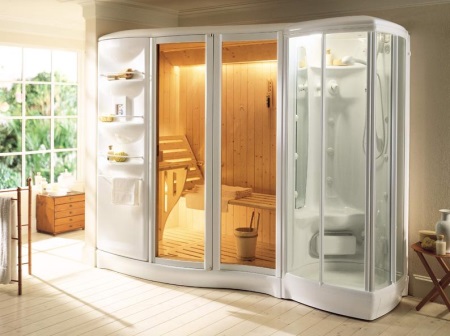
Turkish steam room
Rather exotic type, rarely installed in a city apartment, because it requires certain conditions (installation of a separate hood, good waterproofing, installation of a warm floor, tile decoration and others). To receive steam, a steam generator is installed in the home hammam.






We bought a Finnish sauna in our private house - now we take baths with friends. At the time of building a house on the sauna did not think about the problem, but solved the problem this way. Very convenient!